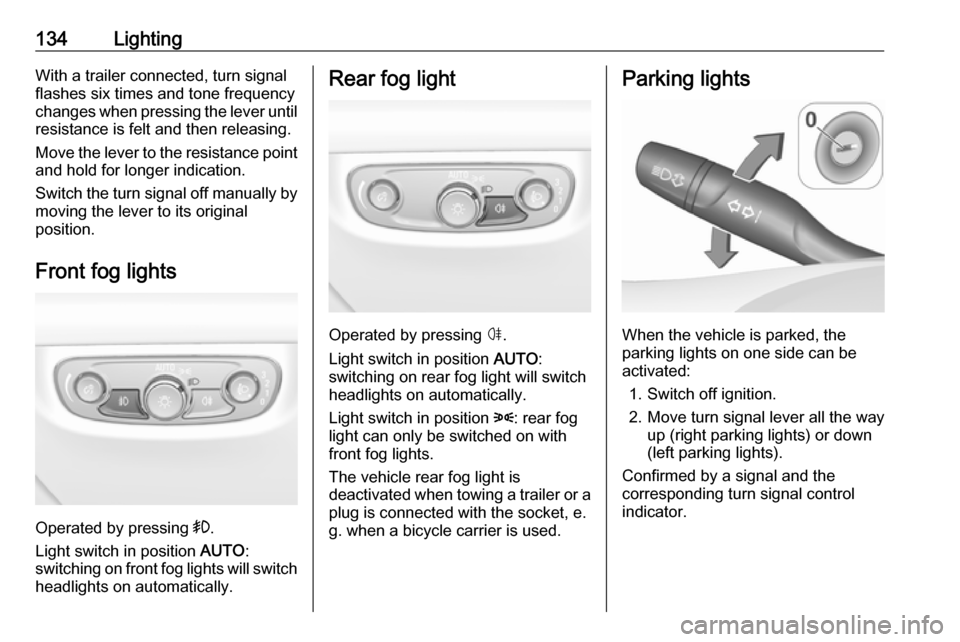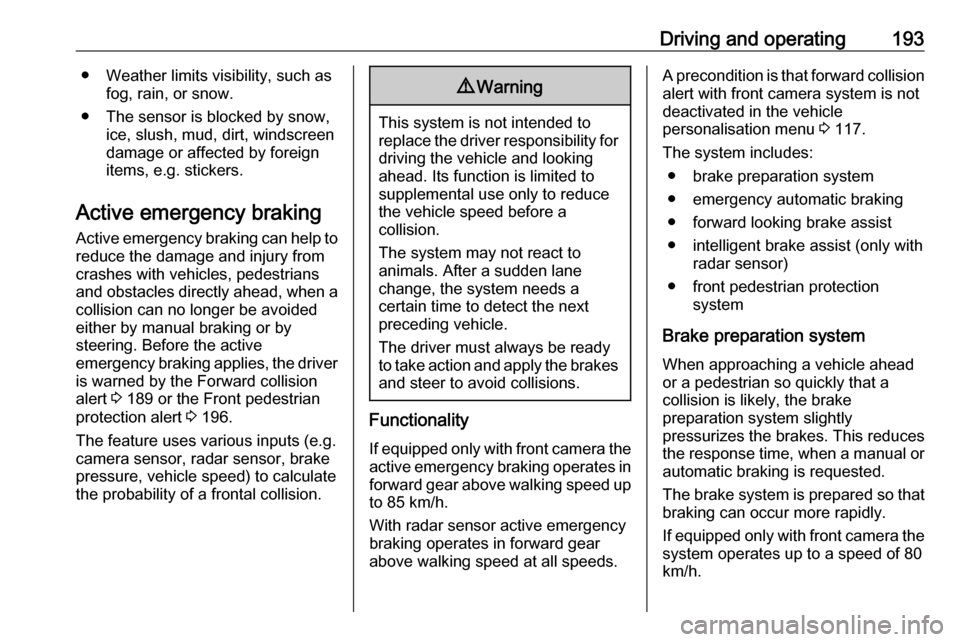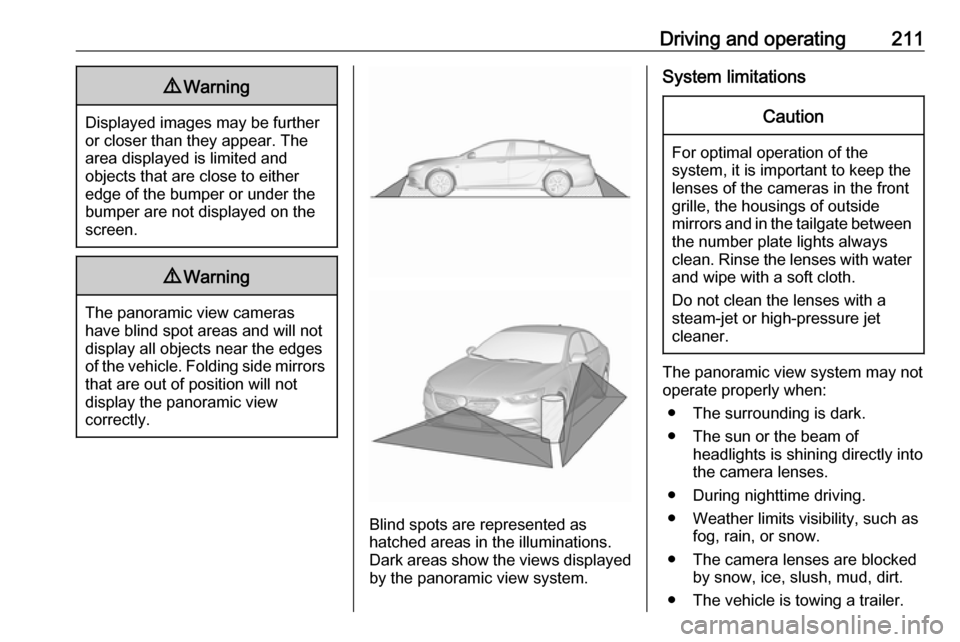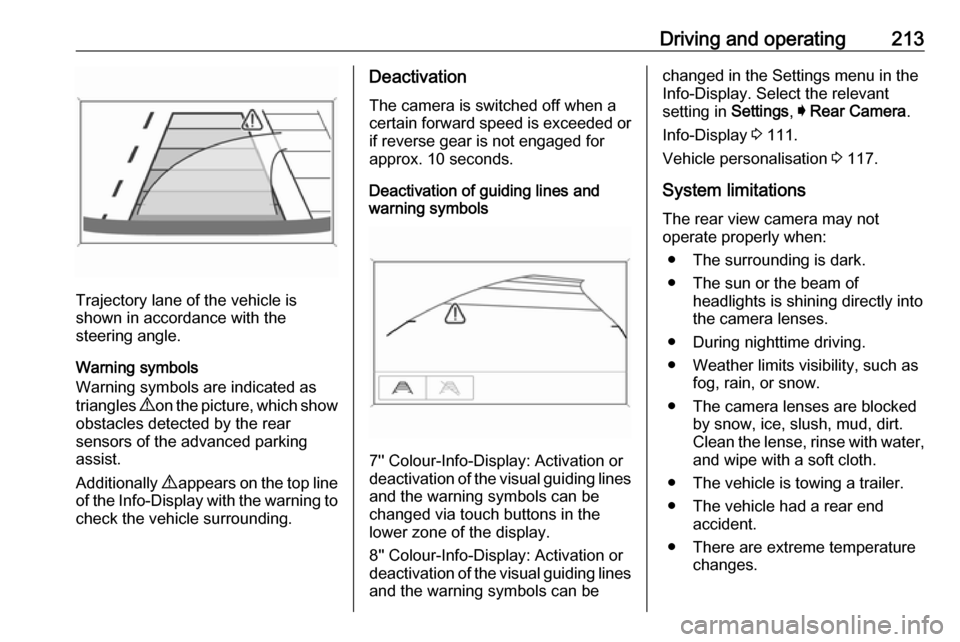fog light OPEL INSIGNIA BREAK 2017.5 Manual user
[x] Cancel search | Manufacturer: OPEL, Model Year: 2017.5, Model line: INSIGNIA BREAK, Model: OPEL INSIGNIA BREAK 2017.5Pages: 303, PDF Size: 8.46 MB
Page 134 of 303

132LightingActivate high beam assist by pushing
the indicator lever twice. High beam is switched on automatically at a speed
above 50 km/h. High beam is
switched off at a speed below
35 km/h, but high beam assist
remains active.Indicator lever with f button
Activate high beam assist by pressing
f once. High beam is switched on
automatically at a speed above
50 km/h. High beam is switched off at
a speed below 35 km/h, but high
beam assist remains active.
The green control indicator f
illuminates continuously when the
high beam assist is activated, the blue one 7 illuminates when high beam is
on.
Control indicator f 3 102, 7
3 102.
Pressing indicator lever once
switches on manual high beam
without high beam assist.
High beam assist switches
automatically to low beam when:
● Driving in urban areas.
● Camera detects heavy fog.
● Front or rear fog lights are switched on.
If there are no restrictions detected, the system switches back to high
beam.
DeactivationIndicator lever with or without MENU
button
If high beam assist is active and high
beam is on, pull indicator lever once
to deactivate high beam assist.If high beam assist is active and high
beam is off, push indicator lever twice
to deactivate high beam assist.
Pushing the indicator lever to activate manual high beam will also
deactivate high beam assist.Indicator lever with f button
If high beam assist is active and high beam is on, press f once or pull
indicator lever once to deactivate high
beam assist.
If high beam assist is active and high
beam is off, press f once to
deactivate high beam assist.
Pushing the indicator lever to activate manual high beam will also
deactivate high beam assist.Headlight flash in conjunction with
high beam assist
Headlight flash by pulling indicator
lever once will not deactivate high beam assist when high beam is off.
Headlight flash by pulling indicator
lever once deactivates high beam
assist when high beam is on.
Page 136 of 303

134LightingWith a trailer connected, turn signalflashes six times and tone frequency changes when pressing the lever until
resistance is felt and then releasing.
Move the lever to the resistance point
and hold for longer indication.
Switch the turn signal off manually by moving the lever to its original
position.
Front fog lights
Operated by pressing >.
Light switch in position AUTO:
switching on front fog lights will switch headlights on automatically.
Rear fog light
Operated by pressing ø.
Light switch in position AUTO:
switching on rear fog light will switch
headlights on automatically.
Light switch in position 8: rear fog
light can only be switched on with
front fog lights.
The vehicle rear fog light is
deactivated when towing a trailer or a
plug is connected with the socket, e.
g. when a bicycle carrier is used.
Parking lights
When the vehicle is parked, the
parking lights on one side can be
activated:
1. Switch off ignition.
2. Move turn signal lever all the way up (right parking lights) or down
(left parking lights).
Confirmed by a signal and the
corresponding turn signal control
indicator.
Page 195 of 303

Driving and operating193● Weather limits visibility, such asfog, rain, or snow.
● The sensor is blocked by snow, ice, slush, mud, dirt, windscreen
damage or affected by foreign
items, e.g. stickers.
Active emergency braking Active emergency braking can help toreduce the damage and injury from
crashes with vehicles, pedestrians
and obstacles directly ahead, when a
collision can no longer be avoided
either by manual braking or by
steering. Before the active
emergency braking applies, the driver
is warned by the Forward collision
alert 3 189 or the Front pedestrian
protection alert 3 196.
The feature uses various inputs (e.g.
camera sensor, radar sensor, brake
pressure, vehicle speed) to calculate
the probability of a frontal collision.9 Warning
This system is not intended to
replace the driver responsibility for driving the vehicle and looking
ahead. Its function is limited to
supplemental use only to reduce
the vehicle speed before a
collision.
The system may not react to
animals. After a sudden lane
change, the system needs a
certain time to detect the next
preceding vehicle.
The driver must always be ready
to take action and apply the brakes and steer to avoid collisions.
Functionality
If equipped only with front camera the
active emergency braking operates in forward gear above walking speed up
to 85 km/h.
With radar sensor active emergency
braking operates in forward gear
above walking speed at all speeds.
A precondition is that forward collision
alert with front camera system is not
deactivated in the vehicle
personalisation menu 3 117.
The system includes: ● brake preparation system
● emergency automatic braking ● forward looking brake assist
● intelligent brake assist (only with radar sensor)
● front pedestrian protection system
Brake preparation system
When approaching a vehicle ahead
or a pedestrian so quickly that a
collision is likely, the brake
preparation system slightly
pressurizes the brakes. This reduces
the response time, when a manual or automatic braking is requested.
The brake system is prepared so that braking can occur more rapidly.
If equipped only with front camera the
system operates up to a speed of 80
km/h.
Page 213 of 303

Driving and operating2119Warning
Displayed images may be further
or closer than they appear. The
area displayed is limited and
objects that are close to either
edge of the bumper or under the
bumper are not displayed on the
screen.
9 Warning
The panoramic view cameras
have blind spot areas and will not
display all objects near the edges
of the vehicle. Folding side mirrors that are out of position will not
display the panoramic view
correctly.
Blind spots are represented as
hatched areas in the illuminations.
Dark areas show the views displayed by the panoramic view system.
System limitationsCaution
For optimal operation of the
system, it is important to keep the
lenses of the cameras in the front
grille, the housings of outside
mirrors and in the tailgate between the number plate lights always
clean. Rinse the lenses with water and wipe with a soft cloth.
Do not clean the lenses with a
steam-jet or high-pressure jet
cleaner.
The panoramic view system may not
operate properly when:
● The surrounding is dark.
● The sun or the beam of headlights is shining directly into
the camera lenses.
● During nighttime driving.
● Weather limits visibility, such as fog, rain, or snow.
● The camera lenses are blocked by snow, ice, slush, mud, dirt.
● The vehicle is towing a trailer.
Page 215 of 303

Driving and operating213
Trajectory lane of the vehicle is
shown in accordance with the
steering angle.
Warning symbols
Warning symbols are indicated as
triangles 9 on the picture, which show
obstacles detected by the rear
sensors of the advanced parking
assist.
Additionally 9 appears on the top line
of the Info-Display with the warning to
check the vehicle surrounding.
Deactivation
The camera is switched off when a
certain forward speed is exceeded or
if reverse gear is not engaged for
approx. 10 seconds.
Deactivation of guiding lines and
warning symbols
7'' Colour-Info-Display: Activation or
deactivation of the visual guiding lines and the warning symbols can be
changed via touch buttons in the
lower zone of the display.
8'' Colour-Info-Display: Activation or
deactivation of the visual guiding lines
and the warning symbols can be
changed in the Settings menu in the
Info-Display. Select the relevant
setting in Settings, I Rear Camera .
Info-Display 3 111.
Vehicle personalisation 3 117.
System limitations The rear view camera may not
operate properly when:
● The surrounding is dark.
● The sun or the beam of headlights is shining directly into
the camera lenses.
● During nighttime driving.
● Weather limits visibility, such as fog, rain, or snow.
● The camera lenses are blocked by snow, ice, slush, mud, dirt.Clean the lense, rinse with water, and wipe with a soft cloth.
● The vehicle is towing a trailer.
● The vehicle had a rear end accident.
● There are extreme temperature changes.
Page 231 of 303

Vehicle care229Vehicle careGeneral Information...................229
Accessories and vehicle modifications .......................... 229
Vehicle storage ........................230
End-of-life vehicle recovery .....230
Vehicle checks ........................... 231
Performing work ......................231
Bonnet ..................................... 231
Engine oil ................................. 232
Engine coolant ......................... 233
Washer fluid ............................ 234
Brakes ..................................... 234
Brake fluid ............................... 234
Vehicle battery ......................... 235
Diesel fuel system bleeding .....236
Wiper blade replacement ........237
Bulb replacement .......................237
Halogen headlights ..................237
LED headlights ........................ 239
Fog lights ................................. 239
Tail lights ................................. 240
Side turn signal lights ..............243
Number plate light ...................244
Interior lights ............................ 244
Instrument panel illumination ...244Electrical system ........................244
Fuses ....................................... 244
Engine compartment fuse box . 245
Instrument panel fuse box .......248
Vehicle tools .............................. 249
Tools ........................................ 249
Wheels and tyres .......................250
Winter tyres ............................. 250
Tyre designations ....................251
Tyre pressure .......................... 251
Tyre pressure monitoring system .................................... 252
Tread depth ............................. 254
Changing tyre and wheel size . 255
Wheel covers ........................... 255
Tyre chains .............................. 255
Tyre repair kit .......................... 256
Wheel changing .......................260
Spare wheel ............................ 262
Jump starting ............................. 264
Towing ....................................... 266
Towing the vehicle ...................266
Towing another vehicle ...........267
Appearance care .......................268
Exterior care ............................ 268
Interior care ............................. 270General Information
Accessories and vehiclemodifications
We recommend the use of genuine
parts and accessories and factory approved parts specific for your
vehicle type. We cannot assess or guarantee reliability of other products
- even if they have a regulatory or
otherwise granted approval.
Any modification, conversion or other changes made to standard vehicle
specifications (including, without
limitation, software modifications,
modifications of the electronic control
units) may invalidate the warranty
offered by Opel. Furthermore, such
changes may impact fuel
consumption, CO 2 emissions and
other emissions of the vehicle and
cause the vehicle to no longer
conform to the operating permit,
impacting the validity of your vehicle
registration.
Page 241 of 303

Vehicle care239High beam (2)
1. Rotate the cap anticlockwise andremove it.
2. Disengage bulb holder bypressing the retainer to the front.
Withdraw the bulb holder from the
reflector housing.
3. Detach the bulb from the bulb holder and replace the bulb.
4. Insert the bulb holder.
5. Fit the cap and rotate clockwise.
Front turn signal light
In case of defective LEDs, have them replaced by a workshop.
Side light
In case of defective LEDs, have them
replaced by a workshop.
Daytime running light
In case of defective LEDs, have them
replaced by a workshop.
LED headlights
Headlights for low and high beam,
sidelights, daytime running lights and turn signal lights are designed as
LEDs and cannot be changed.
Have lights repaired by a workshop in
case of failure.
Fog lights
Page 244 of 303

242Vehicle careLamp assembly in the tailgate
1. Release the cover in the tailgateand remove it.
2. Unscrew the plastic securing nutby hand.
3. Carefully withdraw the lampassembly from the recesses and
remove.
4. Turn the bulb carrier anticlockwise and remove it from
the lamp assembly.
Rear fog light ( 1)
Reverse light ( 2)
5. Remove and replace the bulb:
Rear fog light
Page 248 of 303

246Vehicle careNo.Circuit1–2–3ABS4–5–6Tailgate7Fog light8Memory module9Heated windscreen10Seat lumbar11DC/DC battery12Heated rear window13Heated mirror14–15–16Front wiper17Power seat, passengerNo.Circuit18Sunblind19Power seat, driver20–21Sunroof22Rear wiper/Airbag23Adaptive forward lighting24–25–26Transmission control module27Ignition/Instrument panel28–29Rear view camera/Air vent30Malfunction indicator light/
Trailer31–32Camera33Seat heat front34Seat heat rearNo.Circuit35Damping/All-wheel drive36Fuel system37–38–39–40Steering wheel lock41–42–43Heated steering wheel44Headlight range adjustment45–46Engine control module47–48DC/DC converter/Air vent/E-
Boost49Rear door control module50–51–
Page 299 of 303

297Child restraint systems ................59
Climate control ............................. 16
Clock............................................. 83
Collision damage repair ..............290
Control indicators.......................... 97
Control of the vehicle .................153
Controls ........................................ 79
Convex shape .............................. 33
Coolant and antifreeze ...............272
Cruise control ....................103, 178
Cupholders .................................. 68
Curtain airbag system .................. 57
Curve lighting.............................. 130
D Danger, Warnings and Cautions ...4
Daytime running lights ...............130
Declaration of conformity ............288
DEF ............................................ 162
Diesel exhaust fluid ....................162
Diesel fuel system bleeding .......236
Diesel particle filter ....................160
Door open .................................. 103
Doors ............................................ 28
Driver assistance systems ..........178
Driver Information Centre ...........104
Driving characteristics and towing tips .............................. 225
Driving hints ................................ 153E
Electric adjustment ......................33
Electrical system......................... 244
Electric parking brake ...........99, 171
Electric parking brake fault ...........99
Electronic climate control system 143
Electronic key system ...................21
Electronic Stability Control.......... 174
Electronic Stability Control and Traction Control system ..........100
Electronic Stability Control off..... 100
End-of-life vehicle recovery .......230
Engine compartment fuse box ...245
Engine coolant ........................... 233
Engine coolant temperature ......101
Engine coolant temperature gauge ....................................... 96
Engine data ............................... 280
Engine exhaust .......................... 160
Engine identification ...................276
Engine oil ................... 232, 272, 277
Engine oil pressure ....................101
Entry lighting .............................. 137
Event data recorders ..................293
Exit lighting ................................ 137
Exterior care .............................. 268
Exterior light ............................... 102
Exterior lighting ....................13, 126
Exterior mirrors ............................. 33F
First aid ......................................... 75
First aid kit ................................... 75
Fixed air vents ........................... 150
Fog light ..................................... 102
Fog lights ................................... 239
Folding mirrors ............................. 33
Following distance ......................100
Following distance indication ......192
Forward collision alert................. 189
Front airbag system .....................56
Front fog lights ........................... 134
Front pedestrian protection ........196
Front seats.................................... 42
Front storage ................................ 69
Fuel............................................. 221
Fuel consumption - CO 2-
Emissions ............................... 224
Fuel for diesel engines ..............222
Fuel for petrol engines ...............221
Fuel gauge ................................... 95
Funnel......................................... 222
Fuses ......................................... 244
G Gauges ......................................... 93
Gear shifting ............................... 100
General information ...................225
Glovebox ..................................... 68